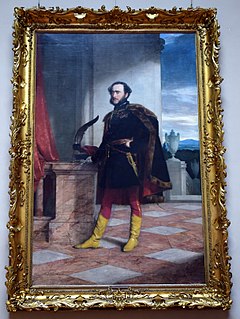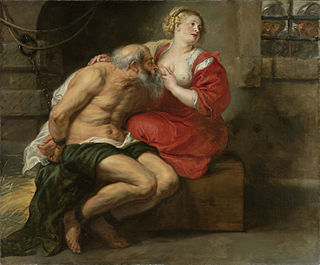 W
WLa Circassienne au Bain, also known as Une Baigneuse, was a large Neoclassical oil painting from 1814 by Merry-Joseph Blondel depicting a life-sized young Circassian woman bathing in an idealized setting from classical antiquity. The painting was destroyed with the sinking of the RMS Titanic in 1912. When financial compensation claims were filed with US commissioner Gilchrist in January 1913, the painting gained notoriety as the subject of the largest claim made against the White Star Line for the loss of a single item of baggage or cargo.
 W
WThe Coronation of Napoleon is a painting completed in 1807 by Jacques-Louis David, the official painter of Napoleon, depicting the coronation of Napoleon I at Notre-Dame de Paris. The painting has imposing dimensions, as it is almost 10 metres (33 ft) wide by a little over 6 metres (20 ft) tall and was completed in the medium of oil painting. The work is on display at the Louvre Museum in Paris.
 W
WThe portrait of Count István Széchenyi is a monumental painting by Austrian painter Friedrich von Amerling. It belongs to the Art Collection of the Hungarian Academy of Sciences in Budapest, where it portrays the founder of the institution. It has the same elaborate Rococo frame as the contemporary painting of From Darkness, the Light by Johann Ender. The painting is probably the most famous portrait of Széchenyi, the greatest statesman of the Hungarian Reform Era.
 W
WDavid Garrick Between Tragedy and Comedy is a 1761 painting by the English painter Joshua Reynolds, depicting the actor and playwright David Garrick caught between the Muses of Tragedy and Comedy. It is regarded as one of Reynolds's most studied and well-known paintings, and is now in the collection of Waddesdon Manor, Buckinghamshire.
 W
WThe Death of Socrates is an oil on canvas painted by French painter Jacques-Louis David in 1787. The painting focuses on a classical subject like many of his works from that decade, in this case the story of the execution of Socrates as told by Plato in his Phaedo. In this story, Socrates has been convicted of corrupting the youth of Athens and introducing strange gods, and has been sentenced to die by drinking poison hemlock. Socrates uses his death as a final lesson for his pupils rather than fleeing when the opportunity arises, and faces it calmly. The Phaedo depicts the death of Socrates and is also Plato's fourth and last dialogue to detail the philosopher's final days, which is also detailed in Euthyphro, Apology, and Crito.
 W
WThe Distribution of the Eagle Standards is an 1810 oil painting by Jacques-Louis David depicting a military ceremony in 1804 that was arranged by Napoleon after his assumption of power as Emperor of the French. In the ceremony, Napoleon sought to revive the military ethos of the Roman Empire.
 W
WEcho and Narcissus is a 1903 oil painting by John William Waterhouse. It illustrates the myth of Echo and Narcissus from Ovid's Metamorphoses.
 W
WFrom Darkness, the Light or Allegory of the Hungarian Academy of Sciences is a monumental painting by Johann Ender in the Art Collection of the Hungarian Academy of Sciences in Budapest. It is also the official symbol of the institution, the main motif constituting its logo.
 W
WGoethe in the Roman Campagna is a painting by Johann Heinrich Wilhelm Tischbein, a German Neoclassical painter, depicting Johann Wolfgang von Goethe when the writer was travelling in Italy. Goethe's book on his travels to Italy from 1786–88, called Italian Journey, was published in 1816–17; the book is based on his diaries. Since 1887, the painting has been in the possession of the Städel Museum in Goethe's hometown Frankfurt.
 W
WGrande Odalisque, also known as Une Odalisque or La Grande Odalisque, is an oil painting of 1814 by Jean Auguste Dominique Ingres depicting an odalisque, or concubine. Ingres' contemporaries considered the work to signify Ingres' break from Neoclassicism, indicating a shift toward exotic Romanticism.
 W
WThe Intervention of the Sabine Women is a 1799 painting by the French painter Jacques-Louis David, showing a legendary episode following the abduction of the Sabine women by the founding generation of Rome.
 W
WJeune fille en buste is a work by Pierre-Narcisse Guérin painted in 1794 and exhibited at the Louvre.
 W
WJews Praying in the Synagogue on Yom Kippur was painted by Polish Jewish artist Maurycy Gottlieb in 1878. It depicts Jews in the midst of the Yom Kippur service, on one of the holiest days of the Jewish calendar.
 W
WThe Lictors Bring to Brutus the Bodies of His Sons is a work in oils by the French artist Jacques-Louis David. On a canvas of 146 square feet, this painting was first exhibited at the Paris Salon in 1789. The subject is the Roman leader Lucius Junius Brutus, founder of the Roman Republic, contemplating the fate of his sons. They had conspired to overthrow the republic and restore the monarchy, and Brutus himself was compelled to order their deaths. In doing so, Brutus became the heroic defender of the republic, at the cost of his own family. The painting was a bold allegory of civic virtue with immense resonance for the growing cause of republicanism. Its themes of virtue, sacrifice, and devotion to the nation sparked much controversy when it was unveiled in the politically charged era of the French Revolution.
 W
WMars Being Disarmed by Venus is the last painting produced by the French artist Jacques-Louis David. He began it in 1822 during his exile in Brussels and completed it three years later, before dying in an accident in 1825. He sent it to an exhibition in Paris from his exile, knowing that by then Romanticism was ascendant in the Salon. In 2007 it was displayed in the main hall of the Royal Museums of Fine Arts of Belgium in Brussels, close to the entrance.
 W
WOath of the Horatii, is a large painting by the French artist Jacques-Louis David painted in 1784 and now on display in the Louvre in Paris. The painting immediately became a huge success with critics and the public, and remains one of the best known paintings in the Neoclassical style.
 W
WMarie-Guillemine Benoist, born Marie-Guillemine de Laville-Leroux, was a French neoclassical, historical and genre painter.
 W
WThe Portrait of Ferenc Kölcsey is a painting by Anton Einsle in the Art Collection of the Hungarian Academy of Sciences in Budapest. It is probably the most famous portrait of Ferenc Kölcsey, a leading Hungarian poet, literary critic, orator, and politician in the Reform Era, who wrote the Himnusz, the national anthem of Hungary.
 W
WRoman Charity is the exemplary story of a woman, Pero, who secretly breastfeeds her father, Cimon, after he is incarcerated and sentenced to death by starvation.
 W
WThe Spoliarium is a painting by Filipino painter Juan Luna. Luna, working on canvas, spent eight months completing the painting which depicts dying gladiators. The painting was submitted by Luna to the Exposición Nacional de Bellas Artes in 1884 in Madrid, where it garnered the first gold medal. The picture recreates a despoiling scene in a Roman circus where dead gladiators are stripped of weapons and garments. Together with other works of the Spanish Academy, the Spoliarium was on exhibit in Rome in April 1884.